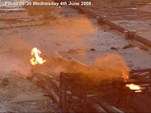This post is receiving a lot of attention from around the world so, although, at the moment, the workplace safety issues have diminished, it is interesting to note that The Australian newspaper for 12 June 2008 reports that the Premier, Alan Carpenter, has acknowledged that he may need to invoke emergency powers to seize control of electricity and gas supplies.
This is an extraordinary development that indicates the infrastructure fragility of Western Australia.
The supply disruption is now also receiving federal government attention as it begins to affect Australia’s ability to supply China’s insatiable appetite for Australian minerals and energy.
Alcoa Australia is the latest company to announce a “force majeure” as a result of the Apache Energy pipeline explosion.
It is phenomenal to see how an event that in OHS terms is a “near miss” has the potential to weaken a country’s economic growth.


